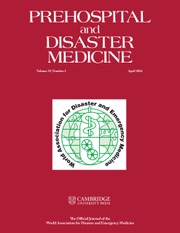No CrossRef data available.
Article contents
Nighttime Cardiopulmonary Resuscitation: Evaluating Feasibility and Quality in Low-Light and Headlamp Conditions
Published online by Cambridge University Press: 22 May 2025
Abstract
The European Resuscitation Council (ERC) establishes guidelines for cardiopulmonary resuscitation (CPR) under standard conditions and special circumstances but without specific instructions for nighttime situations with reduced visibility. The aim of this study was to evaluate the feasibility of performing CPR at night under two different conditions, in darkness with ambient light and with the additional illumination of a headlamp, as well as to determine the quality of the maneuver.
A crossover, randomized pilot study involving nineteen lifeguards was conducted, with each participant performing two five-minute CPR tests: complete darkness with headlamp and natural night environment at the beach without additional lighting. Both tests were conducted with a 30:2 ratio of chest compression (CC) to ventilations using mouth-to-pocket mask technique in the darkness of the night with a 30-minute break between them. Outcome measures included quality of CPR, number of CCs, mean depth of CCs, mean rate of CCs, and number of effective ventilations. Results were reported as the mean or median difference (MD) between the two groups with 95% confidence interval (CI) using techniques for paired data.
There were no statistically significant differences between the two lighting conditions for the outcomes of CPR quality, mean depth of CCs, or number of effective ventilations. The number of CCs was lower when performed without the headlamp (MD: -8; 95%CI, -15 to 0). In addition, the mean rate of CCs was lower when performed without the headlamp (MD: -3; 95%CI, -5 to -1).
The rescuers performed CPR at night with good quality, both in darkness and with the illumination of a headlamp. The use of additional lighting with a headlamp does not appear to be essential for conducting resuscitation.
Information
- Type
- Innovation Report
- Information
- Copyright
- © The Author(s), 2025. Published by Cambridge University Press on behalf of World Association for Disaster and Emergency Medicine


